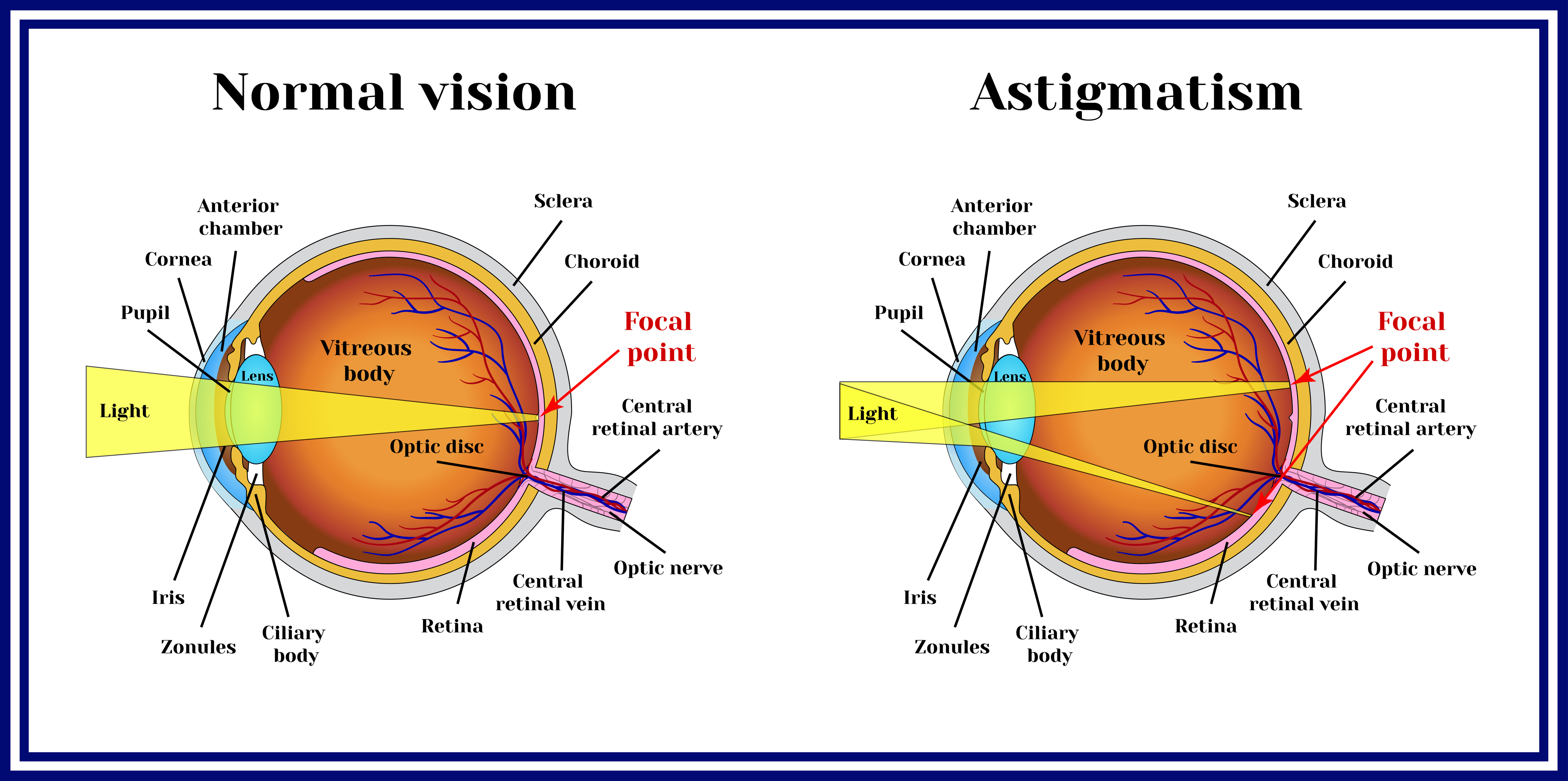
How Astigmatism Affects Your Night Vision: Understanding Visual Impairments After Dark
Posted by Team Debby on 17th Dec 2023
How Astigmatism Affects Your Night Vision: Understanding Visual Impairments After Dark
Astigmatism is a common refractive error that alters the way light enters the eye, leading to blurry or distorted vision. An astigmatic cornea has an irregular shape, often compared to that of a football. This shape change means that light rays are not focused evenly on the retina, the light-sensitive tissue at the back of the eye. As a result, vision can be blurry at any distance, both close up and far away.

Night vision is particularly affected by astigmatism due to the conditions under which our eyes must operate in the dark. In low light, pupils dilate to allow more light to enter the eye. However, a larger pupil means that more of the irregularly shaped cornea is utilized, exaggerating the light's improper focus and intensifying the blurriness or distortion. For those with astigmatism, this often manifests as halos around light sources, glare, or difficulty discerning contrast between objects and their background. These symptoms can pose challenges when navigating in dark or dimly lit environments.
Key Takeaways
- Astigmatism causes blurry or distorted vision due to an irregularly shaped cornea.
- Enlarged pupils in low light exacerbate vision issues for individuals with astigmatism.
- Astigmatism can cause difficulties with night vision such as halos and glare.
Understanding Astigmatism

Astigmatism is a common refractive error caused by an imperfection in the curvature of the eye's cornea or lens. We'll discuss how this condition affects light focusing and the variations it can come in.
The Role of the Cornea and Lens
The cornea and lens of our eyes work in tandem to refract, or bend, incoming light onto the retina, which results in the images we see. In a perfect optical system, these structures have a smooth, equally curved surface, resembling the shape of a basketball. However, in an eye with astigmatism, the surface of the cornea or lens has an irregular shape, more akin to a football. This irregularity leads to a refractive error where light rays don't meet at a common focal point, causing blurred or distorted vision, especially at night when our pupils dilate.
Types of Astigmatism:
- Corneal Astigmatism: Occurs when the cornea has an irregular shape.
- Lenticular Astigmatism: Results from an irregularly shaped lens inside the eye.
Both types of astigmatism can cause difficulties in seeing fine details.
Types of Astigmatism
Astigmatism can be classified by the cause of the irregularity in curvature:
- Corneal Astigmatism: This is when the cornea, the clear front surface of the eye, possesses uneven curvature. We see more commonly this type impacting vision because the cornea plays a significant role in focusing light.
| Curvature Type | Characteristics |
|---|---|
| With-the-rule | Vertical meridian steeper than horizontal |
| Against-the-rule | Horizontal meridian steeper than vertical |
| Oblique | Steeper curve lies between 120 and 150 degrees or 30 and 60 degrees |
- Lenticular Astigmatism: Less common than corneal astigmatism, lenticular astigmatism arises when the crystalline lens inside our eyes is distorted. This variety can sometimes develop due to age or in conjunction with other eye conditions.
| Factor | Impact on Vision |
|---|---|
| Lens Shape | Results in distortions similar to corneal astigmatism but may not affect overall corneal curvature |
In both types, the irregular shape of the cornea or lens leads to refractive errors that affect how we perceive the world, both during the day and at night.
Symptoms and Diagnosis of Astigmatism

In this section, we focus on the identification of astigmatism through its symptoms and how it is diagnosed by professionals.
Common Symptoms
Symptoms of astigmatism can vary among individuals, but the following are frequently reported:
- Blurry vision: Objects appear blurred at any distance.
- Difficulty with night vision: Our ability to see in low-light conditions is compromised.
- Eye strain: We often experience general discomfort or tiredness in the eyes.
- Headaches: Due to the strain of trying to focus, we might suffer frequent headaches.
- Squinting: We may find ourselves squinting in an attempt to see more clearly.
Experiencing any combination of these symptoms could indicate astigmatism and warrants further investigation.
Professional Diagnosis
Diagnosing astigmatism typically involves a comprehensive eye exam:
- Visual Acuity: We read from an eye chart to determine how well we can see at various distances.
- Keratometry: Measures the curvature of the cornea to identify irregularities.
- Refraction: Determines our prescription using lenses of different strengths.
- Eye Dilation: The eye doctor may dilate our pupils to examine the retina and optic nerve.
An accurate diagnosis of astigmatism will enable us to receive the correct prescription for glasses or contact lenses, or explore other corrective options.
Astigmatism and Night Vision

Astigmatism can significantly impact our night vision, often resulting in difficulty with glare and reduced clarity of images under low-light conditions. We're going to explore how astigmatism affects our ability to see at night and the challenges it presents, particularly when driving after dark.
Effects on Night Vision
Astigmatism distorts light as it enters the eye, causing it to focus on multiple points rather than on a single point on the retina. At night, our pupils naturally dilate to allow more light to enter, but for those of us with astigmatism, this can exacerbate the issue. Images may appear blurred or stretched, and we might experience a range of visual disturbances, including:
- Halos: Bright circles that appear to surround light sources.
- Starbursts: Rays extending from bright lights.
- Glare: Excessive brightness that can cause discomfort or pain.
These visual artifacts are particularly troublesome in low-light conditions, as the contrast between dark surroundings and bright lights is more pronounced, leading to more severe distortions.
Challenges with Night Driving
Driving at night poses specific challenges for us with astigmatism. The artificial lighting from streetlights and oncoming headlights can become problematic, creating a halo effect or glare that makes it difficult to maintain clear vision. Concerns and experiences may include:
- Difficulty with oncoming headlights: The lights can appear extremely bright with halos and starburst, making it hard to see the road clearly.
- Struggle with glare: Streetlights and traffic lights may cause significant glare, which can be disorienting or momentarily blinding.
The necessity to constantly adjust focus between varying light intensities and distances can lead to eye strain and fatigue. Our ability to judge distances, read road signs, and react to sudden changes can also be impaired, which underlines the importance of addressing astigmatism, especially for those of us who frequently drive at night.
Treatment Options for Astigmatism

We understand that effective treatment for astigmatism is essential for improving vision, especially at night. Options range from non-invasive corrective lenses to more permanent surgical interventions.
Corrective Lenses and Contact Lenses
For mild to moderate astigmatism, glasses or contact lenses are usually the first treatment option recommended. Here's how they work:
- Glasses: Specifically crafted eyeglasses with cylindrical lens power effectively correct the uneven curvature of the cornea or the lens of the eye.
- Contact Lenses: Soft toric contact lenses allow for a comfortable and precise fit, targeting the astigmatism directly. However, for those with higher degrees of the condition, rigid gas permeable contact lenses or hybrid lenses might be prescribed.
- Toric Contact Lenses: They have different powers in various meridians of the lens to compensate for the irregular shape of the cornea.
- Orthokeratology (Ortho-K): Wearing specially designed rigid gas-permeable contact lenses overnight reshapes the cornea, temporarily correcting the astigmatism.
Surgical Treatments
Surgery might be an option for those seeking a more permanent solution, often leading to a reduced dependence on glasses or contact lenses:
- LASIK (Laser-Assisted In Situ Keratomileusis): A laser reshapes the cornea to correct the refractive error. Most suitable for individuals with a stable prescription.
- PRK (Photorefractive Keratectomy): Similar to LASIK, but instead of creating a flap, the entire outer layer of the cornea is removed before reshaping it with a laser.
- Lens Implants: For those who cannot undergo corneal refractive surgery, toric lens implants can be inserted during cataract surgery to correct astigmatism.
- Laser Surgeries: Involve reshaping the curvature of the cornea to correct the refractive error.
- Lens Implants: Toric lens implants are surgically placed inside the eye to provide a permanent correction.
Surgical treatments require in-depth consultations and are dependent on individual eye structures and health condition.
Living with Astigmatism

Astigmatism can significantly impact night vision, causing discomfort and blurriness. We'll discuss how to manage daily activities with this condition and the importance of monitoring and care.
Managing Daily Activities
With astigmatism, routine tasks can become challenging, especially under low light conditions. We must recognize the potential for eye strain and adopt strategies to cope with the distorted vision.
For example, we can ensure our homes are well-lit to reduce glare and shadows that exacerbate visual difficulties. When engaging in activities that require precise vision, such as reading or using digital screens, it's beneficial to take regular breaks. We can also use assistive devices like lighting controls or screen magnifiers.
Driving at night is another activity where astigmatism can pose issues, as headlights and street lights may appear blurred or haloed. We may find night driving glasses with anti-reflective coating helpful in reducing glares from oncoming traffic or the rearview mirror.
Adjusting vehicle mirrors to minimize reflections and keeping windshields clean are practical steps we can take to maintain clarity of vision on the road.
Monitoring and Care
Regular monitoring of astigmatism is crucial for maintaining optimal eye health. Eye exams should be scheduled with an eye care professional at least once a year, or more frequently if advised.
These exams can help detect not only changes in our astigmatism but also the onset of related eye diseases, such as cataracts, or any signs of injury that may affect our vision.
Children with astigmatism require special attention, as their eyes change rapidly with age. A pediatrician or eye specialist should monitor their vision development, and corrective measures like glasses or contact lenses should be updated accordingly.
This ensures that both nearsightedness (myopia) and farsightedness (hyperopia) are appropriately managed, providing children with the best possible visual acuity.
Maintaining open communication with our eye care professionals allows for personalized recommendations on managing discomfort or blurriness.
They can suggest tailor-made solutions such as specific lens coatings or prescription changes that reflect the severity and type of astigmatism.
Through their guidance, we can continue to live fully despite this vision problem.
Frequently Asked Questions

In this section, we address common concerns regarding how astigmatism can affect night vision, detailing both the challenges it presents and possible solutions.
Does astigmatism cause difficulties with night driving?
Astigmatism often leads to problems with night driving due to the distortion of light, which reduces vision clarity. This can make it more challenging to see road signs and obstacles.
What is the effect of astigmatism on light sensitivity?
Our sensitivity to light increases if we have astigmatism, particularly in low-light conditions. This is because the irregular shape of the cornea or lens in our eyes can cause light to scatter more, leading to glare.
How can you improve night vision if you have astigmatism?
Improving night vision can be accomplished by obtaining a correct prescription for glasses or contact lenses. Additionally, anti-reflective coatings and specially tinted lenses can help reduce glare.
Why does astigmatism cause lights to appear as starbursts at night?
Astigmatism causes lights to appear as starbursts or halos at night due to the irregular curvature of the cornea or lens. This curvature disrupts the normal path of light entering our eyes, leading to the starburst effect.
What are the best glasses to wear for night driving with astigmatism?
For night driving with astigmatism, glasses with a current prescription are crucial. Lenses with anti-reflective coating are often recommended to minimize glare and enhance clarity.
Why is vision often blurrier at night for individuals with astigmatism?
Individuals with astigmatism often experience blurrier vision at night. This happens because their eyes have difficulty focusing on light sources properly.
The effects of astigmatism are more pronounced in the dark. This is because the pupils dilate, exacerbating the problem.


